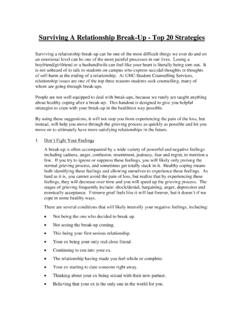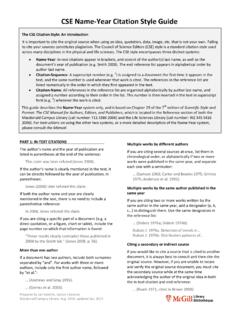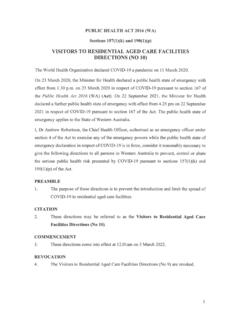Transcription of Guidelines to Effective Hydration in Aged Care Facilities
1 Guidelines to Effective Hydrationin aged care FacilitiesPrepared by Associate Professor Michael WoodwardMedical Director, aged & residential care ServicesHeidelberg Repatriation HospitalApril 2013 Over 160,000 Australians receive permanent residential aged care services1 and the vast majority of these are either physically or cognitively impaired. The illnesses that lead to admission into residential care may in turn make it more difficult for care staff to maintain the residents nutrition and Hydration . There has been very public community concern about the quality of residential care , and both poor nutrition and inadequate Hydration have been appropriately cited as indicators of inadequate care2-4. These clinical Guidelines have been developed as a practical tool for residential care staff to better manage one aspect of quality care Hydration and to better prevent and manage dehydration in this is a reduction in total body water volume and may be defined as significant when over 3% of body weight is lost.
2 However, it is often difficult to determine precisely how much weight has been lost and whether it is all due to water loss. Dehydration is usually regarded as present when it is accompanied by changes in biochemical indices and by clinical features (see below, under diagnosis).Prevalence of dehydration in institutional careStudies within nursing homes have found that dehydration is frequent. One prospective study found dehydration events occurred in 31% of residents over 6 months5. and another found that 98% of residents consumed less than the daily recommended fluid intake6. In another study some 91 of 339 elderly nursing home residents who became ill had biochemical features of hospital admissions of nursing home residents are associated with dehydration and the electrolyte disturbances that may indicate dehydration. In one study, 34% of nursing home patients admitted to hospital were diagnosed with dehydration8.
3 Another study found 84% of hypernatraemic patients developed this during admission to hospital only 16% were hypernatraemic on of dehydrationDehydration is associated with increased hospitalisation and mortality. It may not be easy to distinguish between poor outcomes due to an underlying illness and poor outcomes from dehydration itself. In one study of 130 nursing home residents there were 48 febrile episodes over a 4 month period and 14 febrile residents had biochemical markers of dehydration. Of the 5 febrile residents who died, all had markers of dehydration10. This unintended dehydration and associated increased mortality should be distinguished from the dehydration that frequently accompanies terminal illnesses such as cancer and renal factors for dehydrationThe greatest risk factor for dehydration is poor oral intake. In the study of 48 febrile episodes in nursing home residents, 11 patients were noted by staff to have poor oral intake and nine of these (82%) developed biochemical markers of dehydration10.
4 In a study of hospitalized patients, 86% of patients who developed hypernatraemia in hospital lacked free access to significant risk factors for dehydration in a study of 339 elderly residents who became ill included female gender, age over 85, four or more chronic conditions, use of more than four medications and being bedridden7. Among those who were most severely dehydrated, inability to feed oneself and impaired functional status were additional risk factors. In another study, diuretic use was a risk factor for electrolyte disturbances in elderly people requiring hospitalization12. Diuretic use is a recognised risk factor in the genesis of renal impairment and electrolyte disturbances, especially in older people13, and is likely to increase the risk of dehydration in nursing home availability of appropriately skilled staff to assist residents is also a factor that contributes to the risk of dehydration.
5 Dr Kayser-Jones research in the USA has repeatedly revealed that inadequate staffing, lack of assessment and disregard for personal and cultural preferences contribute to inadequate fluid intake and dehydration in residential care3,6,14. These findings have been replicated by others in a recent study weight loss and dehydration were 17% less likely in Facilities that provided residents with at least 3 hours of nursing assistant care daily compared with those providing less than 3 hours factors for dehydration are summarised in Table One and should alert care staff to being more attentive to fluid intake and the signs of OneRISK FACTORS FOR DEHYDRATIONPOOR ORAL INTAKEs Inability to feed independentlys Refusing oral intakes Poor access to fluidss Oro-pharyngeal diseaseINCREASED FLUID LOSSs Febrile Illnesss Diarrhoea and vomitings Diureticss Illnesses increasing urine outputs unstable diabetess hypercalcaemias hypokalaemiaOTHER FACTORSs Female genders Older ages Greater number of medicationss Impaired functional statuss Dementia and other confusional statess Greater number of illnesses/chronic conditionsINADEQUATE STAFFINGs
6 Inadequate staff training / awareness of hydrationOlder people have a reduced thirst in response to fluid deprivation16 and their hormonal response to dehydration (secretion of anti-diuretic hormone) may also be impaired17. These changes may be even more pronounced in residents with Alzheimer s disease18, a common condition in residential care . These factors both make older people more prone to dehydration and also indicate that thirst cannot be relied upon as an indicator of fluid intakeFluid intake must replace measurable losses (urine, faeces and occasionally others such as drain tubes) and insensible (not easily measured) losses from respiration and through the skin. The recommended minimum total fluid intake is 1500 2000 mL, (equivalent to 6 8 250 mL cups) a day. This comes from all sources including soups and formula used to calculate fluid requirements for older people is:U y ` i } L ` i } v i w }U x y ` i } v i i }U x y ` i } v i>V } >v i } Table Two shows these recommended fluid TwoPatient Weight (kg)Fluid requirement(litres/day)Other formulae for recommended fluid intake are less accurate and may underestimate fluid requirements, especially in underweight residents19.
7 These include 30 mL/kg body weight and 1 mL/kcal energy of dehydrationSigns of dehydration include dry mucous membranes, reduced tissue turgor (elasticity), reduced sweating, sunken eyes, tachycardia, low blood pressure and postural blood pressure drop, altered consciousness including confusion, increasing functional impairment, weakness, constipation, reduced urine output and more concentrated (darker) urine. Unfortunately many of these signs are quite subjective, with no defined normal ranges, and thus poor positive and negative predictive values for the diagnosis of dehydration. Some of these signs can be present in other conditions for instance, low blood pressure can be due to over treatment with medications that lower blood pressure, in cardiac failure and when there is autonomic neuropathy. Indeed, over-reliance on low blood pressure as a sign may lead to over diagnosis of a study of 102 consecutive medical admissions in people older than 65 with a diagnostic coding of dehydration (16% admitted from nursing homes), only 17% had biochemically confirmed dehydration (serum osmolarity above 295 mOsmol) suggesting over-diagnosis by physicians, probably due to over-reliance on physical signs or other less accurate biochemical indices20.
8 Another study of 150 elderly patients and residents with dehydration (defined as hypernatraemia) found that most of the classical signs of dehydration were irregularly present21. There were four signs that were significantly and independently associated with hypernatraemia abnormal subclavicular and thigh skin turgor, dry oral mucosa and recent changes in consciousness. > i> } > Lii v ` Li > i ` V L i > ` i >L i } v ` > 22 tissue or blotting paper is placed in i > > v > vi i > ` v i i` L i > `i ` > } }}i i` i > a recent darkening of urine as a useful sign, as it correlates well with serum osmolarity23 but may be difficult to monitor in incontinent more useful clinical signs of dehydration are shown in Table ThreeMore useful clinical signs of dehydrations ,i` Vi` > > i> }s Reduced skin turgors Dry oral mucosas Recent change in consciousnesss Darker urineDiagnostic tests for dehydration/ i >VV > i i i > q > > i >L i x " ` >} V v i` Vi` L ` > i > L i i Vi > circumstances.
9 Other tests that are used include an elevated blood urea nitrogen to creatinine ratio and an elevated serum sodium although these tests are more liable to be abnormal for reasons other than three values are stable in non-ill residents of nursing homes, so a change from baseline values can be relied on to suggest dehydration has occurred25. A single elevated value in a resident in the absence of clinical features of dehydration is not diagnostic of dehydration some elderly people appear to have an elevated central osmolarity setting25 i > i` i iV wV } > > also be a useful sign but has not been carefully biochemical signs of dehydration are shown in Table FourTable FourBiochemical signs of dehydration*Signs Raised serum osmolalitys Raised serum sodiums Raised blood urea/creatinine ratio* Only diagnostic in the presence of clinical signs of dehydrationValues Above 295 mOsmols Above 145 mmol/Ls Above 50 (urea in mmol/L and creatinine also in mmol/L)Prevention of dehydration in residential careGeneralStaff in residential care Facilities need to be trained to recognise the importance of maintaining adequate Hydration , normal fluid requirements and how to monitor intake.
10 They should also be able to identify situations where a resident is at greater risk of dehydration, clinical features of dehydration and strategies to increase fluid intake. There needs to be adequate staffing levels to attend to Hydration needs, but volunteers and visitors should also be involved in this task. A wide range of strategies to maintain and increase fluid intake have been utilized. Some have been subjected to research studies including regular rounds with a Hydration cart26, using volunteers and providing a happy hour 27 and prompting residents to drink and providing preferred fluids28. Many other approaches are utilized and the key to success appears to be tailoring a program to suit local conditions. Some of the > i} i > V> Li V `i i` > i />L i i V> `> y ` > i > i ` " i] > ` V> i studies are presented in Appendices Two and FiveStrategies to maintain / increase fluid intakes i > >vv > i >`i > i > i` i > Vi v ` > s Regularly offer fluids every 1 hours by days Offer fluids at specific routine eventss before / after showering or washingafter toiletings before / after physiotherapy or other activity programs medication roundss Regular Hydration cart roundss Offer residents their preferred drinkss Prompt residents to drink at meal timess i y ` i `i i>V s ` V> i v> i vvi y ` i }s V >}i i v ` V > i ] V > `] } ] Vi V i> ] ]










